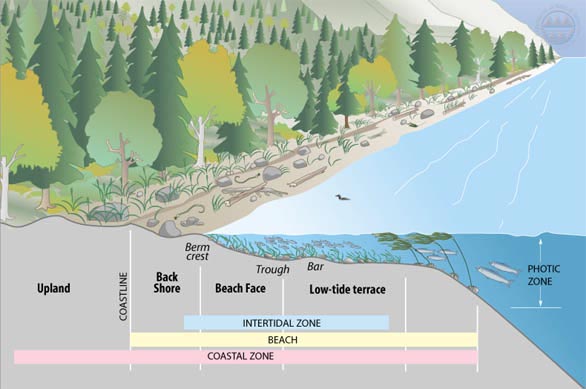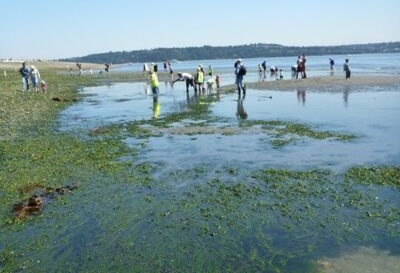Nearshore Habitat:
Puget Sound's Nursery
The beaches, bluffs, estuaries and tidal areas of the Puget Sound nearshore zone are important areas for salmon.
The juvenile salmon of all Puget Sound watersheds use nearshore areas to grow strong before heading to the open ocean. Research links early life stage success to salmon survival rates.
Nearshore habitat also nurtures the food web in estuaries and offshore, providing sustenance for adult salmon and other wildlife in the Sound.
Nearshore habitat can take many forms: kelp and eelgrass beds, rocky or sandy beaches, tidal mudflats, lagoons and estuaries, and salt marshes. Overhanging vegetation and sand/cobble mix beaches are important elements, and estuaries connect freshwater streams and provide resting spaces to migratory fish.

What is the Nearshore?

A Connected System
A well-functioning nearshore stems from upland trees and plants on coastal bluffs, through the estuaries and beaches, and down to the lowest tidal areas.
All of the physical processes work together — from the eroding bluffs that provide new sand and gravel to the trees that provide nutrients, shade, and driftwood. Currents and tides carry these materials and shape the lagoons, spits, and beaches that host our incredible diversity of shore life.
Freshwater streams play a role as well, shaping and filling lagoons and estuaries that host an incredible diversity of birds, wildlife, plants, and fish. This dynamic system supports critical salmon life cycles and the salmon in turn contribute to ecosystem health.
Juvenile salmon have a long journey from the streams where they are born to the ocean where they will spend their adult lives. Salt water marshes and estuaries are an important area for small salmon to get used to saltwater on their outmigration.
Juveniles use the shoreline habitat to feed and find rest stops in the estuaries along their journey. Adult salmon feed on the small forage fish species such as herring, sand lance, and smelt, that live in productive nearshore habitats.
These forage fish need shaded beaches to spawn, and nutrients washed out from the marshes to grow. Overhanging plants attact insects which fish eat when they fall into the water.

Why is the Nearshore Important for Puget Sound Salmon?
A Safe Migration
Juvenile salmon are a tasty treat for many kinds of marine life. Natural nearshore environments can provide safe places for these salmon to hide and rest during their journey to the sea — such as in the eel grass just offshore or in the estuaries that connect to the Sound.
Estuaries also provide a gradient of salt and freshwater, which juvenile salmon can use to support their physical transformation from the rivers to the ocean stages of their life.

A Buffet for a Critical Time
Sea wrack on beaches and overhanging vegetation from shoreline trees and bushes provide nutritious insects for young salmon to eat. This is much more likely to be available on natural shorelines, where vegetation is still intact than on heavily armored areas of the beach.
Estuaries flush nutrients from marshes into the nearshore, which support the forage fish that adult salmon eat on their return trips to spawn. Many other species benefit from healthy nearshore habitats and food webs too!

Forage Fish Spawning
The tide flats of the nearshore are spawning habitat for “forage fish” – the small fish species (including herring and sand lance) that serve as the basis of the food web, and are an essential food source for adult salmon.
These fish spawn either directly on the sand during high tide, or attach their eggs to eel grass just below the water line. Adult salmon, birds, and marine mammals eat these fish – their populations are critical for salmon and ecosystem health.

Challenges for Puget Sound Shorelines
Development Pressures
As our region has grown, shorelines have been prized for their usefulness — easy access to transport ships, low slopes and elevations for building railways and roads, and of course excellent views for housing. The same rivers, bays, and estuaries that support Puget Sound ecology have also attracted human uses and development: shipping, towns, and industry.

Unfortunately, this interrupts important processes that keep the shorelines healthy and cuts off resources that plants and animals need. Historic practices of armoring shorelines also put homes, buildings, and roads at risk. Today the Puget Sound shoreline looks very different and has heavy impacts on salmon and other wildlife.
Armor Disrupts Sediment
Shoreline development, such as jetties and docks, disrupt the flow of sediment along our shores.
Sediment builds up on one side of the armor and gets washed away from the other. Waves actually hit a vertical wall like a seawall harder than if they ran up a natural shore, creating scouring effects that wash important sand out to sea and destroy the nearshore habitat. Small fish no longer have shade for protection, and fewer insects land in the water for food. Sand and cobble are washed away and only larger rocks remain, depleting spawning areas.

Filling In Estuaries
Historically, many estuaries and lagoons were altered for flood control and to convert land for farming. But these spaces were critical to the ecosystem and especially to juvenile salmon.
Nearly 80% of the estuaries have been lost in Puget Sound. Restoring estuaries along the salmon migration corridors is considered a key element to their recovery. Estuary restoration not only helps juvenile salmon, but also adults, who feed on the forage fish that live just outside the estuaries in the nearshore environment and benefit from the nutrients flushed out of these marsh areas.

What Can We Do Now?
As we try to address the decline in salmon, and the overall health of Puget Sound, there is much we can do. From ensuring that future development is better to restoring the function of estuaries and beaches that have been lost.
Many shoreline properties don’t actually need armor, and can benefit from more habitat-friendly approaches such as armor removal or soft-shore designs.
The video below provides some great information on how to manage shorelines naturally. Mid Sound is pleased to work with two Shore Friendly programs in our region, Shore Friendly Kitsap and Shore Friendly King County to help landowners find ways to implement natural solutions that protect their homes while also restoring their beaches.
Our partner organization, Northwest Straights Foundation, created this wonderful video explaining how shoreline management and Puget Sound ecology are connected. Check it out!
Mid Sound's Role
Restoring Estuaries
We are working to restore coastal estuaries, such as our project at Rose Point and the historic salt marsh at Point No Point.
This shoreform, called a barrier embayment, historically had protective sand berms that protected inland habitat while still allowing the saltwater to flush through them during tidal cycles. We are working to restore that connection to create habitat for salmon and wildlife at the park.
We work with coastal engineers to find opportunities to restore these systems and expand the habitat available around the Sound.

Softer Shoreline Design

Now that we know that armor doesn’t work, and really damages our shorelines, we have better tools to design alternatives that still protect property but also support wildlife and fish.
Soft-shore design combines natural beach elements and habitat with engineered solutions that look and act natural to humans and wildlife, but still provide long-term support for homes and infrastructure.
Helping Landowners
We work with shoreline homeowners to remove individual bulkheads and restore more natural shorelines to their property, such as at the Arnold property in Bremerton.
The Shore Friendly program provides education, technical assistance, permitting support and even financial help for pursuing shoreline restoration and habitat-friendly protection projects.
We can help homeowners in King County and Kitsap County determine if Shore Friendly is a resource for their project – contact us for more information!
